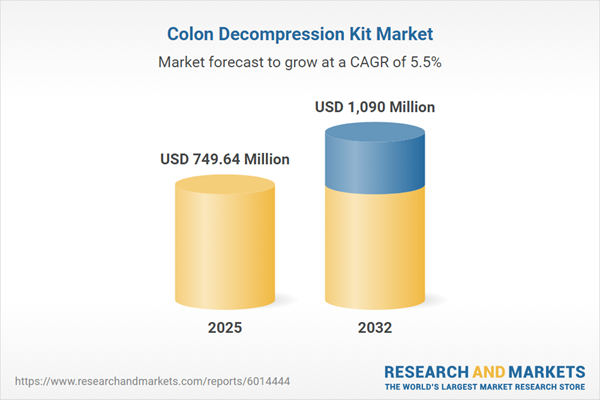Speak directly to the analyst to clarify any post sales queries you may have.
The colon decompression kit market is advancing as healthcare systems increasingly prioritize innovations that streamline clinical workflows and improve patient outcomes. Senior decision-makers are targeting opportunities to adopt adaptive solutions, optimize supply channels, and align new technologies with evolving standards across diverse medical settings.
Market Snapshot: Growth and Trends in the Colon Decompression Kit Market
Between 2024 and 2025, the global colon decompression kit market expanded from USD 710.72 million to USD 749.64 million, with a projected value of USD 1.09 billion by 2032 and a 5.51% CAGR. This growth is closely associated with the increasing adoption of minimally invasive medical devices across integrated healthcare networks. Advanced colon decompression kit technologies are being recognized as standard equipment, attracting supplier innovation and streamlining operational processes. Both traditional hospital environments and emerging homecare models are elevating expectations for scalable and adaptable solutions, while ongoing sector advancements empower clinical teams to deliver more efficient and consistent care.
Scope & Segmentation: Comprehensive Analysis of the Colon Decompression Kit Market
- Product Types: Automated reusable kits, manual reusable kits, premium single-use kits, and standard single-use kits provide a comprehensive range of solutions designed for varying clinical workflows and operational demands.
- Applications: These kits are integrated into general clinics, specialty clinics, inpatient and outpatient care settings, assisted homecare, and scenarios where patients are involved in self-administration, leading to flexible care pathways and increased patient participation.
- End Users: Healthcare professionals, nurses, and physicians, as well as both adult and pediatric patients, utilize these kits, demonstrating their adaptability and multi-disciplinary value.
- Distribution Channels: Hospitals procure directly; distributor partnerships expand reach; digital platforms (manufacturer and third-party); and pharmacy networks—both large and independent—support market access and ensure robust supply chains.
- Regions Covered: Americas (including North and Latin America), Europe, Middle East & Africa, and Asia-Pacific all present individual regulatory, logistical, and go-to-market factors shaping supplier approaches and regional strategies.
- Technology Landscape: Integrated sensors, automation features, biocompatible materials, digital monitoring functions, and modular or portable construction enable streamlined procedures and support both remote and onsite healthcare delivery.
Key Takeaways: Strategic Insights for Senior Leadership
- Automated workflows and integration with digital diagnostics enhance reliability and safety, supporting standardized care practices across complex systems.
- Portability and modularity in kit design address the need for adaptable care—from acute hospital settings to patient homes—providing solutions that fit evolving models of care delivery.
- Manufacturers are responding to sustainability initiatives and compliance trends by developing features that align with current and future industry requirements and organizational processes.
- Effective supply chain strategies—combined with diversified distribution—reduce exposure to risk and allow rapid adaptation to shifting market and policy environments.
- User-driven product development helps address adoption challenges and supports the integration of colonic decompression kits within broad institutional and homecare settings.
- Close collaboration between suppliers and distributors accelerates the adoption of innovations, helping organizations keep pace with increasing system complexity and operational demands.
Tariff Impact: United States Policies and Global Supply Chain Adaptation
Recent shifts in United States tariff regulations have influenced procurement of colon decompression kits, directly affecting costs for sourcing and raw materials. Manufacturers and distributors have adapted by reevaluating supplier relationships and logistics models to contain costs and maintain supply consistency. This impact is especially pronounced in the Americas and Asia-Pacific, where active supply management strategies are critical for stabilizing prices and ensuring reliable distribution even as global trade conditions continue to shift.
Methodology & Data Sources
This analysis draws upon peer-reviewed studies, clinical registries, and insights from healthcare practitioners, procurement managers, and product engineers. The methodology emphasizes actionable intelligence, connecting decision-makers with relevant, evidence-based insights for planning and operational execution.
Why This Report Matters: Benefits for Executive Decision-Makers
- Executives can identify emerging market opportunities and allocate development resources in line with the latest care delivery models for enhanced patient engagement and growth.
- The analysis provides a roadmap for anticipating regulatory changes, improving procurement frameworks, and shaping supply chain strategies across different regions.
- Leadership teams gain actionable insights to facilitate technology adoption and foster ongoing performance improvements in a dynamic healthcare marketplace.
Conclusion: Actionable Intelligence for Leadership Strategy
Senior leaders will find the insights in this report support informed decision-making and strategic adaptability. Applying these findings empowers organizations to innovate and continually improve care delivery in a changing healthcare environment.
Additional Product Information:
- Purchase of this report includes 1 year online access with quarterly updates.
- This report can be updated on request. Please contact our Customer Experience team using the Ask a Question widget on our website.
Table of Contents
3. Executive Summary
4. Market Overview
7. Cumulative Impact of Artificial Intelligence 2025
Companies Mentioned
The companies profiled in this Colon Decompression Kit market report include:- Olympus Corporation
- KARL STORZ SE & Co. KG
- Fujifilm Holdings Corporation
- Boston Scientific Corporation
- Medtronic plc
- Cook Medical LLC
- Teleflex Incorporated
- B. Braun Melsungen AG
- ConvaTec Group plc
- Smith & Nephew plc
Table Information
| Report Attribute | Details |
|---|---|
| No. of Pages | 191 |
| Published | October 2025 |
| Forecast Period | 2025 - 2032 |
| Estimated Market Value ( USD | $ 749.64 Million |
| Forecasted Market Value ( USD | $ 1090 Million |
| Compound Annual Growth Rate | 5.5% |
| Regions Covered | Global |
| No. of Companies Mentioned | 11 |









